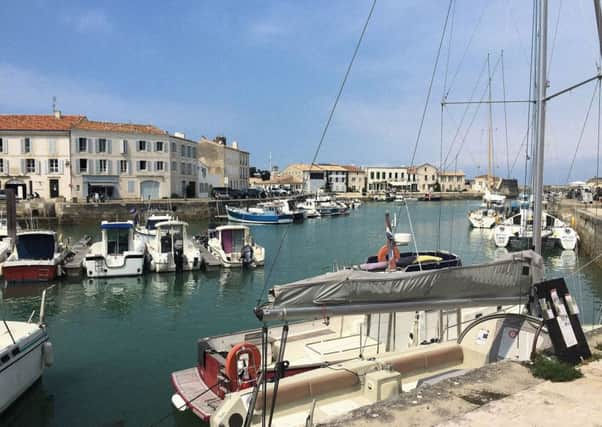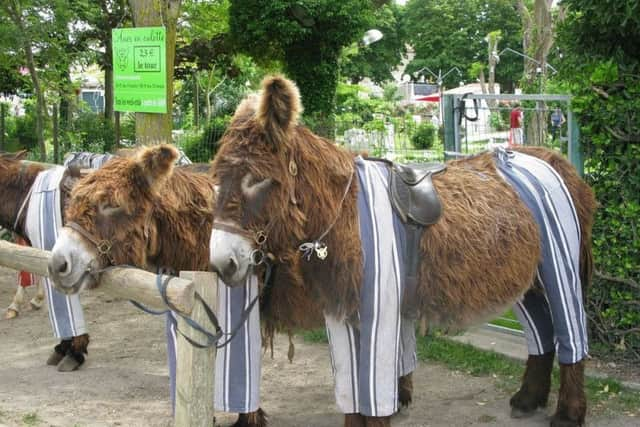Travel: Ile de Re


The Île de Ré is a wildly fashionable island just off the coast of La Rochelle. So fashionable that more than half of the properties are holiday homes owned by wealthy French families, with some British and other nationalities. It is also home to a prison, but nothing like Alcatraz, or indeed the Isle of Wight. It is a place of small towns and villages with cobbled streets, tiny fishermen’s cottages with blinding white walls and blue shutters and doors, hanging baskets, gardens full of hollyhocks, and above all sea views.
Reached via a toll bridge, we hired a car from La Rochelle airport with some difficulty, but there are alternatives. The most popular form of transport is the bicycle and bike hire shops are in every small town on the island. There is nothing nicer than pootling along quiet roads, maybe free-wheeling through the lanes, to the pretty inland villages, the beaches, the harbours, the markets; all are accessible on an island just 19km long. It is charmingly old-style French seaside life, which explains its popularity, and its label as the island of bicycles.
Advertisement
Hide AdThere are taxis, but they are expensive because everything must come from La Rochelle, and now there is a new Tuk-Tuk service which does the job of an aerated taxi – fine in good weather, chillier in the early and late season. The Tuk-Tuk proprietor, Christophe, offers a guided tour, which is not to be missed. We discovered more harbours, more villages, the vineyards, a view across the sea to La Rochelle, some smallholdings with local produce of real quality creating its own market, and the amazing salt marshes.


We heard about the island’s experience during the Second World War and learnt that the islanders are known as sauniers, for the prime historical crop was the fine Île de Ré salt. Christophe’s wife, who is a native, inherited her salt beds. He is an incomer, but with no less of a love and enthusiasm for his adopted island.
Another day we discovered the island’s lighthouse, the Phare des Baleines, named after a number of whales washed up nearby. The first tower was built in 1682, while the current lighthouse, some 57 metres high, was inaugurated in 1854, and from the top the view from this most northerly point of the island is of the sweep of sea and sky.
Climbing the steps of the lighthouse was exhausting and made me long for some pampering. At Sainte-Marie-de-Ré, we found it in a very French thalasso spa in a low building with views of the beach and the vineyard. The name derives from the Greek for sea, so there is a seawater swimming pool, sauna, hammam and treatment rooms for facials and massages, using Labiomer products based on seawater and algae. Because this is France, there is also an excellent restaurant with dishes featuring local seafood and salt marsh lamb.
The food on the island is generally of a high standard. There is fish, seafood, and oysters from the local oyster beds. One of the best chefs on the island is at the Hotel de Toiras in Saint-Martin-de-Ré, the main town on the island. Named after Marshal Toiras, who successfully repelled the English under the Duke of Buckingham in 1627, it is a small conversion of a town house, and its dining room is even smaller, so that it is very difficult to get a table there unless you are resident. And as a Relais & Chateaux property, it is expensive.


Other restaurants we found were Le Chat Botté in Saint-Clément-des-Baleines, and back in Saint-Martin, La Baleine Bleue and O Parloir, a restaurant which proved that young chefs here are experimenting with other cuisines and flavourings, and not sticking solely to the classical French dishes. It was buzzing with locals, always a good sign, and easy to find “right opposite the prison”, as we were told.
Advertisement
Hide AdThat prison fortress, on the outskirts of Saint-Martin, once housed Alfred Dreyfus en route to Devil’s Island. It is now reserved for the most dangerous of French criminals, but none has ever escaped. If you are interested, there are intriguing grainy black and white photographs of 19th century life in the prison – and on the island in general – in the small but excellent museum in Saint-Martin.
Perhaps one of the most curious and characteristic sights on Île de Ré is the island's donkeys and their natty attire – they wear trousers. These are nice stripy pyjamas, blue or pink, and put on the animals to shield the skin of their legs from either the thorny undergrowth of the island’s vegetation or, the alternative explanation, the mosquitoes which plague them in the summer months. They have become a popular symbol of the island. Anyone seeking to emulate Cleopatra in her bath of asses’ milk should try the wonderfully soothing and luxurious donkey milk soap produced here.
Advertisement
Hide AdThe modern crossbreed of donkey found throughout the island is grey, huge and hairy with long dreadlocks, and so used to posing for photographs that they could be said to be the Kardashians of the donkey world.
The other unique thing about the island for me, is its glorious sunsets. We stayed in Saint-Martin in La Maison Douce, a conversion of several tiny cottages with a pretty inner courtyard garden, and from here we could walk through the backstreets down to the harbour. There, sitting in a café on the harbour wall, a pre-dinner drink to hand and anticipating a menu with some more great seafood, the lights of the cafés and restaurants would come on and in the dusk there was a pearly pinkness blending the sea, the sky, and the town.